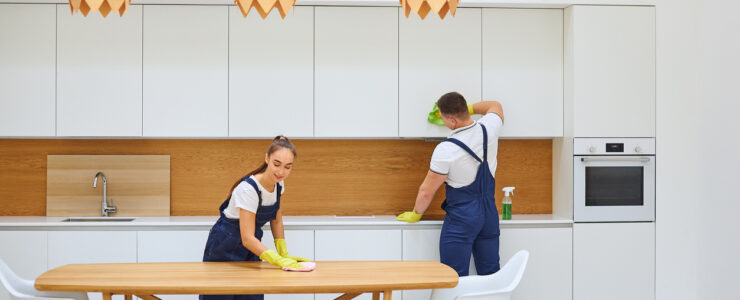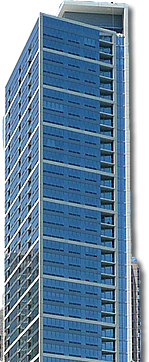
The break room. The common room. The kitchen. Whatever your company calls it, the purpose is usually the same: to provide a shared space for employees to relax, eat, and unwind from the stresses of a day on the job.
Break rooms are some of the most commonly used spaces in a workplace. They’re also some of the dirtiest.
One room continuously cohabited by a large volume of people guarantees the presence of germs – and lots of them. During cold and flu season especially, you can be sure that a microbiological zoo of bugs is thriving on the handle of every refrigerator and the button panel of every microwave.
As your building moves toward reopening, we’d like to provide a few quick tips to help you reduce the spread of germs in your office.
Because, while the accumulation of germs, bugs, and other microbiological monsters can’t be mitigated for good by a single cleaning, there are some common measures that you and your coworkers can take to make the break room a cleaner (and subsequently safer) space for everyone.
1. All hands on deck: Make handwashing consistent.
Here’s a frightening fact: 39% of people don’t wash or disinfect their hands after coughing or sneezing.
And more than half of Americans don’t wash their hands after touching shared equipment, public transportation, and other heavily trafficked surfaces.
That’s a lot of germs being transferred onto the keyboards, phone handles, and desktops of your workplace. Here’s what you can do to reduce risk.
Wash your hands when you enter or exit the break room.
Beyond desks and door handles, a lot of those germs are making their way into your break room or kitchen, where employees are transferring them directly into their mouths or onto their faces. You can cut down on the spread of germs between spaces and people by washing your hands regularly, especially when entering or exiting a room.
Get everyone on board.
Everyone knows this, of course. But you can add signage, send email reminders, and even invest in supplies of alcohol-based hand sanitizers to increase compliance on this fundamental hygiene practice.
2. Common space requires common attention.
Besides washing your hands when you enter or exit a room, you should also pay particular attention to the transfer of germs in common areas.
As mentioned above, break rooms feature some of the most commonly used and widely shared surfaces in a workplace, such as:
- Countertops
- Doorknobs and handles
- Tables, chairs, and other furniture items
You can mitigate the spread of germs on these surfaces by doing things like:
Frequently cleaning and disinfecting shared surfaces.
These spaces are used by virtually everyone in a work environment, and it only takes one sick employee to decommission an entire office from the spread of germs on commonly shared surfaces.
If you only have shared surfaces cleaned every week or two, germs and bugs will have greater opportunities to thrive. You can disinfect countertops, doorknobs, and furniture between deep office cleanings to reduce health risks.
Washing your own hands after touching shared surfaces.
To protect your own health, wash your hands after touching doorknobs or other shared surfaces. This will help to cool down this commonly overlooked hot bed of microbiological activity.
Pro tip: Keep alcohol-based hand sanitizers or spray near the doorways of your break room to encourage frequent cleaning and keep cleanliness top of mind for your staff.
3. Clean the nooks and crannies.
On average, you touch 300 surfaces every 30 minutes, exposing you to over 840,000 germs. That’s 1,680,000 germs every hour.
While many of those germs live on common surfaces like the ones we’ve discussed above, it’s important to note that your break room is also home to many overlooked spaces like refrigerator handles, sink knobs, drawers, and microwave buttons.
These places are commonly overlooked, but they can be fertile breeding grounds for a nasty strain of the flu or the common cold.
Simply wiping down these less-commonly cared for surfaces with a disinfecting wipe can drastically cut down on the number of germs or bugs present.
4. Keep the inside of the fridge clean, too.
While maintaining sanitary conditions on the exterior of the communal fridge is key to keeping your business’s break room clean, maintaining order on inside of the fridge is crucial as well. Here are two practical tips to help.
Don’t use your hands.
For example, if your break room ice box has an ice scooper, use it. If not, every employee that uses ice is dipping their hands into a germ-infested area that’s prone to housing bugs and viruses.
Don’t leave spills to sit.
Clean old food, spills, and crumbs out of the fridge often. For one thing, no one wants to find takeout from six months ago after it’s turned blue. For another thing, the crumbs and old food that are left to sit and rot are prime sources for harmful bacteria to flourish. The mess in your fridge can jeopardize the health of the entire office.
A note on disinfecting protocols:
In the wake of the COVID-19 pandemic, many people have asked us what disinfecting steps need to be taken to protect against the virus. The good news is that regular cleaning procedures – like those listed above – will do the job.
In fact, the Center for Disease Control and Prevention recently updated its guidance on cleaning and disinfecting everyday household surfaces, saying that in “most situations” with no known coronavirus exposure, a thorough scrub with soap and water (as opposed to disinfectant sprays and wipes) will suffice to ward off COVID-19.
CDC Director Dr. Rochelle Walensky said that “disinfection is only recommended… where there has been a suspected or confirmed case of COVID-19, within the last 24 hours.”
The bottom line is that best practices are still best practices – for your break room and your entire building.
Here’s to keeping your workplace safe this season and beyond.
Washing your hands and disinfecting shared surfaces and often-ignored surfaces will help to mitigate the spread of germs and viruses between surfaces and individuals. You can carry out these simple practices yourself, and they’ll have a measurable impact in creating a healthy environment.
And if you’d like more help keeping your workplace safe and your tenants and employees healthy, get in touch with us.
At The Wilburn Company, we’re passionate about cleaning for health. While no cleaning can keep germs away forever, our innovative cleaning practices are designed to be as efficient and effective as possible.
We’re always available to help keep your people healthy and your building safe – and your break room as clean as possible.










